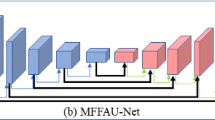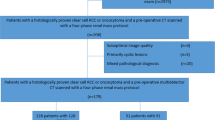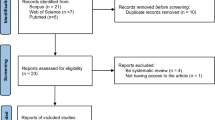Abstract
Introduction
Accurate diagnosis and treatment of kidney tumors greatly benefit from automated solutions for detection and classification on MRI. In this study, we explore the application of a deep learning algorithm, YOLOv7, for detecting kidney tumors on contrast-enhanced MRI.
Material and methods
We assessed the performance of YOLOv7 tumor detection on excretory phase MRIs in a large institutional cohort of patients with RCC. Tumors were segmented on MRI using ITK-SNAP and converted to bounding boxes. The cohort was randomly divided into ten benchmarks for training and testing the YOLOv7 algorithm. The model was evaluated using both 2-dimensional and a novel in-house developed 2.5-dimensional approach. Performance measures included F1, Positive Predictive Value (PPV), Sensitivity, F1 curve, PPV-Sensitivity curve, Intersection over Union (IoU), and mean average PPV (mAP).
Results
A total of 326 patients with 1034 tumors with 7 different pathologies were analyzed across ten benchmarks. The average 2D evaluation results were as follows: Positive Predictive Value (PPV) of 0.69 ± 0.05, sensitivity of 0.39 ± 0.02, and F1 score of 0.43 ± 0.03. For the 2.5D evaluation, the average results included a PPV of 0.72 ± 0.06, sensitivity of 0.61 ± 0.06, and F1 score of 0.66 ± 0.04. The best model performance demonstrated a 2.5D PPV of 0.75, sensitivity of 0.69, and F1 score of 0.72.
Conclusion
Using computer vision for tumor identification is a cutting-edge and rapidly expanding subject. In this work, we showed that YOLOv7 can be utilized in the detection of kidney cancers.



Similar content being viewed by others
Abbreviations
- YOLO:
-
You only look ones
- PPV:
-
Positive predictive value
- ccRCC:
-
Clear cell renal cell carcinoma
- AML:
-
Angiomyolipoma
- HLRCC:
-
Hereditary leiomyomatosis and renal cell cancer
- RCC:
-
Renal cell carcinoma
- mAP:
-
Mean average PPV
References
Padala SA, Barsouk A, Thandra KC, Saginala K, Mohammed A, Vakiti A, et al. Epidemiology of Renal Cell Carcinoma. World J Oncol. 2020;11(3):79-87.
Escudier B, Porta C, Schmidinger M, Rioux-Leclercq N, Bex A, Khoo V, et al. Renal cell carcinoma: ESMO Clinical Practice Guidelines for diagnosis, treatment and follow-up. Annals of Oncology. 2019;30(5):706-20.
Cooper S, Flood TA, Khodary ME, Shabana WM, Papadatos D, Lavallee LT, et al. Diagnostic Yield and Complication Rate in Percutaneous Needle Biopsy of Renal Hilar Masses With Comparison With Renal Cortical Mass Biopsies in a Cohort of 195 Patients. American Journal of Roentgenology. 2019;212(3):570-5.
Cotta BH, Meagher MF, Bradshaw A, Ryan ST, Rivera-Sanfeliz G, Derweesh IH. Percutaneous renal mass biopsy: historical perspective, current status, and future considerations. Expert Review of Anticancer Therapy. 2019;19(4):301-8.
Sahni VA, Silverman SG. Biopsy of renal masses: when and why. Cancer imaging : the official publication of the International Cancer Imaging Society. 2009;9(1):44-55.
Rybicki FJ, Shu KM, Cibas ES, Fielding JR, VanSonnenberg E, Silverman SG. Percutaneous biopsy of renal masses: sensitivity and negative predictive value stratified by clinical setting and size of masses. American Journal of Roentgenology. 2003;180(5):1281-7.
Fonseca RB, Straub Hogan MM, Kapp ME, Cate F, Coogan A, Arora S, et al. Diagnostic renal mass biopsy is associated with individual categories of PADUA and RENAL nephrometry scores: Analysis of diagnostic and concordance rates with surgical resection. Urol Oncol. 2021;39(6):371.e7-.e15.
Kim JH, Sun HY, Hwang J, Hong SS, Cho YJ, Doo SW, et al. Diagnostic accuracy of contrast-enhanced computed tomography and contrast-enhanced magnetic resonance imaging of small renal masses in real practice: sensitivity and specificity according to subjective radiologic interpretation. World Journal of Surgical Oncology. 2016;14(1):260.
Elkassem AMA, Lo SS, Gunn AJ, Shuch BM, Dewitt-Foy ME, Abouassaly R, et al. Role of Imaging in Renal Cell Carcinoma: A Multidisciplinary Perspective. RadioGraphics. 2021;41(5):1387-407.
Pierorazio PM, Johnson MH, Ball MW, Gorin MA, Trock BJ, Chang P, et al. Five-year analysis of a multi-institutional prospective clinical trial of delayed intervention and surveillance for small renal masses: the DISSRM registry. Eur Urol. 2015;68(3):408-15.
Wang W, Cao K, Jin S, Zhu X, Ding J, Peng W. Differentiation of renal cell carcinoma subtypes through MRI-based radiomics analysis. European radiology. 2020;30(10):5738-47.
Oren O, Gersh BJ, Bhatt DL. Artificial intelligence in medical imaging: switching from radiographic pathological data to clinically meaningful endpoints. The Lancet Digital Health. 2020;2(9):e486-e8.
Erickson BJ, Korfiatis P, Akkus Z, Kline TL. Machine Learning for Medical Imaging. Radiographics. 2017;37(2):505-15.
Fu X, Liu H, Bi X, Gong X. Deep-Learning-Based CT Imaging in the Quantitative Evaluation of Chronic Kidney Diseases. Journal of Healthcare Engineering. 2021;2021:3774423.
Lay N, Anari PY, Chaurasia A, Firouzabadi FD, Harmon S, Turkbey E, et al. Deep learning-based decision forest for hereditary clear cell renal cell carcinoma segmentation on MRI. Medical physics. 2023.
Anari PY, Lay N, Chaurasia A, Gopal N, Samimi S, Harmon S, et al. Automatic segmentation of clear cell renal cell tumors, kidney, and cysts in patients with von Hippel-Lindau syndrome using U-net architecture on magnetic resonance images. ArXiv. 2023.
Gudbjartsson H, Patz S. The rician distribution of noisy mri data. Magn Reson Med. 1995;34(6):910-4.
Wang C-Y, Bochkovskiy A, Liao H-YM. YOLOv7: Trainable bag-of-freebies sets new state-of-the-art for real-time object detectors. arXiv preprint arXiv:220702696. 2022.
Nikpanah M, Xu Z, Jin D, Farhadi F, Saboury B, Ball MW, et al. A deep-learning based artificial intelligence (AI) approach for differentiation of clear cell renal cell carcinoma from oncocytoma on multi-phasic MRI. Clinical imaging. 2021;77:291-8.
Xi IL, Zhao Y, Wang R, Chang M, Purkayastha S, Chang K, et al. Deep Learning to Distinguish Benign from Malignant Renal Lesions Based on Routine MR Imaging. Clinical Cancer Research. 2020;26(8):1944-52.
Lopes Vendrami C, McCarthy RJ, Villavicencio CP, Miller FH. Predicting common solid renal tumors using machine learning models of classification of radiologist-assessed magnetic resonance characteristics. Abdominal Radiology. 2020;45(9):2797-809.
Uhm K-H, Jung S-W, Choi MH, Shin H-K, Yoo J-I, Oh SW, et al. Deep learning for end-to-end kidney cancer diagnosis on multi-phase abdominal computed tomography. npj Precision Oncology. 2021;5(1):54.
Lin Z, Cui Y, Liu J, Sun Z, Ma S, Zhang X, et al. Automated segmentation of kidney and renal mass and automated detection of renal mass in CT urography using 2.5D U-Net-based deep convolutional neural network. European radiology. 2021;31(7):5021-31.
Bruno F, Arrigoni F, Mariani S, Splendiani A, Di Cesare E, Masciocchi C, et al. Advanced magnetic resonance imaging (MRI) of soft tissue tumors: techniques and applications. La Radiologia medica. 2019;124(4):243-52.
Funding
Foundation for the National Institutes of Health
Author information
Authors and Affiliations
Corresponding author
Additional information
Publisher's Note
Springer Nature remains neutral with regard to jurisdictional claims in published maps and institutional affiliations.
Supplementary Information
Below is the link to the electronic supplementary material.
Rights and permissions
About this article
Cite this article
Anari, P.Y., Lay, N., Zahergivar, A. et al. Deep learning algorithm (YOLOv7) for automated renal mass detection on contrast-enhanced MRI: a 2D and 2.5D evaluation of results. Abdom Radiol 49, 1194–1201 (2024). https://doi.org/10.1007/s00261-023-04172-w
Received:
Revised:
Accepted:
Published:
Issue Date:
DOI: https://doi.org/10.1007/s00261-023-04172-w




